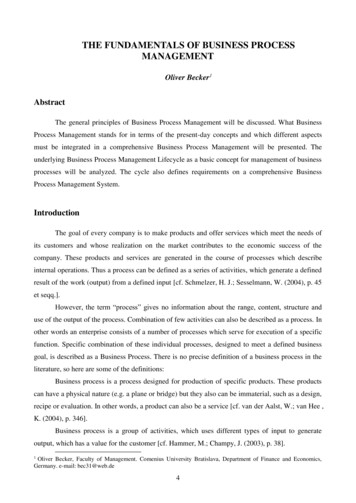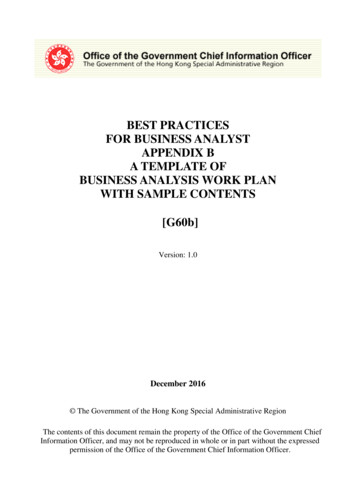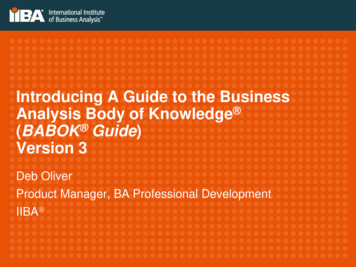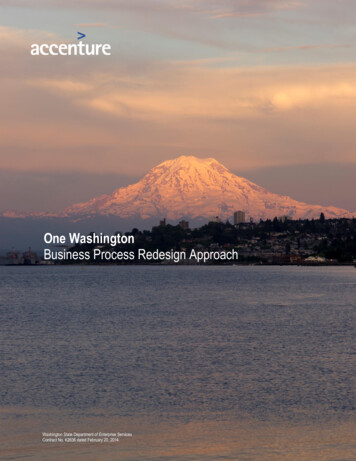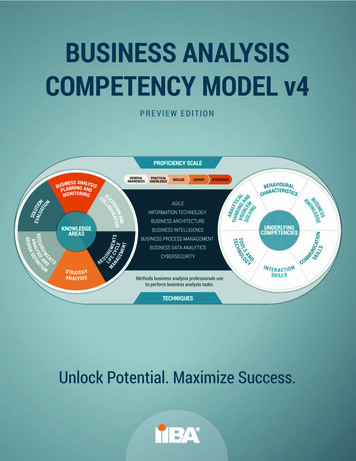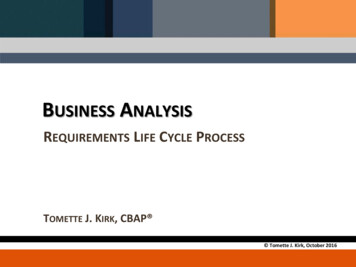
Transcription
BUSINESS ANALYSISREQUIREMENTS LIFE CYCLE PROCESSTOMETTE J. KIRK, CBAP Tomette J. Kirk, October 2016
Learning Objectives Know the Six BABOK Knowledge Areas, The BACCM –Business Analysis Core Concept Model, and the BAUnderlying Competencies Give a Project a “High Five” - Stakeholder, CurrentState, Future State, Gap, and Requirements analysis Understand Business Analysis throughout the entireSolution Development Life Cycle (SDLC) Tomette J. Kirk, October 20162
Presentation Agenda The BAse for Business Analysis Six BABOK Knowledge Areas The BACCM – Business Analysis Core Concept Model Underlying Competencies Giving a Project a “High Five” Business Analysis through the SDLC Tomette J. Kirk, October 20163
THE BASE FOR BUSINESS ANALYSISSIX BABOK KNOWLEDGE AREASTHE BACCM – BUSINESS ANALYSIS CORE CONCEPT MODELADDITIONAL COMPETENCIES Tomette J. Kirk, October 20164
The Six Key Knowledge AreasInternational Institute ofBusiness Analysis Founded 2004 iiba.org BABOK v3 – BusinessAnalysis Body ofKnowledge Ch. 3-8 Ch. 9 Ch. 10 Tomette J. Kirk, October 2016SolutionEvaluationREQsAnalysisand entStrategyAnalysisWhere wouldyou start?5
Reference 1What is Business Analysis?BABOK Guide v2BACCM / BABOK Guide v3.0the practice ofthe set of tasks and techniquesused to work as a liaison amongstakeholders in order toenabling change in an- understand the structure,policies, and operations of anorganization, andby defining needs and- recommend solutions thatenable the organization toachieve its goals Tomette J. Kirk, October 2016organizational contextrecommending solutionsthat deliver valueto stakeholders6
Reference 2The Six Core Concepts Change Need Stakeholder Value Context Solution Tomette J. Kirk, October 20167
Reference 3Core Concept Model: Unified Terminology Uniting a community of practitionersrequires common terminology 6 core concepts kept recurring Each Knowledge Area in the BABOK– Summarizes the KnowledgeArea– Lists the key activities– References the six coreconcepts in relation to thatKnowledge Area Tomette J. Kirk, October 20168
Underlying CompetenciesThese competencies aregrouped into six categories: Analytical Thinking andProblem Solving Behavioral Characteristics Business Knowledge Communication Skills Interaction Skills Tools and Technology Tomette J. Kirk, October 2016 Creative ThinkingDecision MakingLearningProblem SolvingSystems ThinkingConceptual ThinkingVisual Thinking EthicsPersonal AccountabilityTrustworthinessOrganization and TimeManagement AdaptabilityBusiness Acumen Industry KnowledgeOrganization Knowledge Solution KnowledgeMethodology Knowledge Verbal CommunicationNon-VerbalCommunicationWritten CommunicationListeningFacilitationLeadership andInfluencingTeamworkNegotiation and ConflictResolutionTeachingOffice Productivity Toolsand TechnologyBusiness Analysis Toolsand TechnologyCommunication Tools andTechnology9
GIVE A PROJECT A “HIGH FIVE”FIVE ESSENTIAL TASKS FOR EVERY PROJECT Tomette J. Kirk, October 201610
The FIVES of Business AnalysisArtwork byGerald Dias Tomette J. Kirk, October 201611
The Five Analysis Areas for ANY Project On every project we elicit information for:1 StakeholderAnalysis (Who knows it? Who uses it?)2 Current State Analysis (How do you do it now?)3 Future State Analysis (How do you want to do it?)4 Gap Analysis (How do we get from here to there? Buckets)5 Requirements (Details for building and testing it) Not every step is a convoluted process. Eachis scaled to fit the project size/scope. Tomette J. Kirk, October 201612
Stakeholder Analysis Who has a vested INTEREST in the project? Project Sponsor/s Business Areas Organizational Charting Systems / owners Who will be USING the solution? Internal users External Users System interfaces Tomette J. Kirk, October 201613
Current State Analysis What is being done NOW? Process from beginning to end May be an overall picture May be a section of a process 75% of Americans are driven by sensory input Touch, taste, hear, see, smell Can tell you what they DO Can identify pain points in the existing process Tomette J. Kirk, October 201614
Future State Analysis What do you WANT to do? How will the project addresscurrent state pain points? Stakeholders want the pain to go away Most projects try to start here (or you wouldn’t have aproject) Difficult to do without understanding current state Remember: Change Pain (too) Try not to allow “solutions” to outdo “function” Tomette J. Kirk, October 201615
Gap Analysis How do we get from Current State to Future State? What is changing in the Current State?ADD, CHANGE, REMOVE What are the buckets of work in theFuture State that the project will address? Many times these buckets are called Major Features Major Features are NOT requirements They cannot be built or tested They are meant to be used to estimate and organize work What is needed during the transition? May be a short-term solution Tomette J. Kirk, October 201616
Requirements What are the details of the Future State? These must be buildable, testable requirements Requirements are usually Functions of the new solutionPerformed by either Humans or Systems A “function” of the system is about “doing” A functional requirement can be called a user story, asimple use case, a system requirement, a business need. In our new “wagile” world, we need to have a commonlanguage around requirements User stories are not complete for functional REQs Tomette J. Kirk, October 201617
Functional Requirements A well-written functional requirement contains FIVE parts: Who? Does? What? Why? Done When? Traditional Use Case* title isWho? Does? What? Why? comes from the Agile world – good info! Done When? or Success Criteria indicates how you knowthe “Who? Does? What? Why?” was built Tomette J. Kirk, October 201618
The Five Parts Who? Actor in the Requirement I, He, She, It (The Report, The System) Does? Active verb What? The thing being requested Why? What is the reason this is done? Done When? A restatement of the first four, a way of describing theoutcome. Tomette J. Kirk, October 201619
User Stories Aren’t Enough! Tomette J. Kirk, October 201620
Capture Non-functional REQs Too!Two kinds of NFs: 1) Business Rules/Global qualities, 2) Actor/Does/Thing functional-requirements-do-we-really-care Tomette J. Kirk, October 201621
BUSINESS ANALYSIS THROUGH THE SDLCTHE BA ROLE IN A PROJECT LIFECYCLE Tomette J. Kirk, October 201622
What’s the Difference Between a PM & a BA?PROJECT MANAGERSIMILARITIESBUSINESS ANALYSTStrong communication skillsUnderstands the SDLCAble to negotiate and build consensusStrong interpersonal and client management skillsStrong communication skillsUnderstands the SDLCAble to negotiate and build consensusStrong interpersonal and client management skillsAble to see the “big picture” for the projectDirects the project teamHelps project team stay on taskDetail-orientedListens to the stakeholders and SMEsHelps stakeholders and SMEs describe how and why theyperform tasksEnsures the product is built right, following thedocumented requirementsIdentifies issues with the business processes and productdeliveryManages requirements change controlPossesses investigative and listening skillsProjectDIFFERENCESEnsures the project is on time and in budgetRemoves barriers and works through issuesManages project change controlPossesses management skills Tomette J. Kirk, October 2016Product5) Article by Barbara Carkenord nMenu/Events/CurrentArticles1/PM and BA Article.pdf23
REQs in the SDLC (Solution Development Life Cycle)Initiate - Plan - Design - Develop - Test - Deploy - Support Tomette J. Kirk, October 20166- Image from: velopment-lifecycle.html24
REQs in the SDLC (Solution Development Life Cycle)Initiate - Plan - Design - Develop - Test - Deploy - Support Tomette J. Kirk, October 20166- Image from: velopment-lifecycle.html25
So Give Your Project a “High Five!”Analyze: Stakeholders Current State Future State The Gap Requirements Tomette J. Kirk, October 2016Write REQs: Who? Does? What? Why? Done When?26
Questions? Comments?Tomette J. Kirk, CBAP Resource Manager, Humana ITBusiness Analysis Competency Center - BACCC 414.232.9113tkirk2@humana.com Tomette J. Kirk, October 201627
References1)The Business of Business Analysis: Business Analysis Core Concept Model (BACCM)Overview - The Six Core Concepts. Julian Sammy, e.asp?sid 3240&ptid 77&brandid 5015&uid 0&mi 2528482)Webinar: Exploring the BABOK Guide Webinar Series : Episode 2 -The Business AnalysisCore Concept Model Public-Archive.aspx3)Webinar: BABOK V3 and Certification Updates Chapters Leaders, Tuesday, February 24,2015 3:30 PM (and other dates)4)Functional vs. Non-functional requirements: quirements-do-we-really-care5)Article by Barbara Carkenord nMenu/Events/CurrentArticles1/PM and BA Article.pdf6)Image from: velopmentlifecycle.html Tomette J. Kirk, October 201628
Learning Objectives Know the Six BABOK Knowledge Areas, The BACCM –Business Analysis Core Concept Model, and the BAUnderlying Competencies Give a Project a “High Five” - Stakeholder, CurrentState, Future State, Gap, and Requirements analysis Understand Business Analysis throughout the entireSolution Development Life Cycle (SDLC) Tomette J. Kirk, October 201629
Business Analysis Core Concept Model, and the BA Underlying Competencies Give a Project a “High Five” - Stakeholder, Current State, Future State, Gap, and Requirements analysis Understand Business Analysis throu

